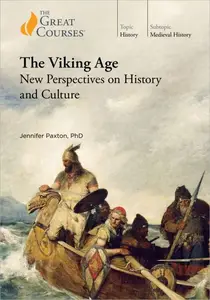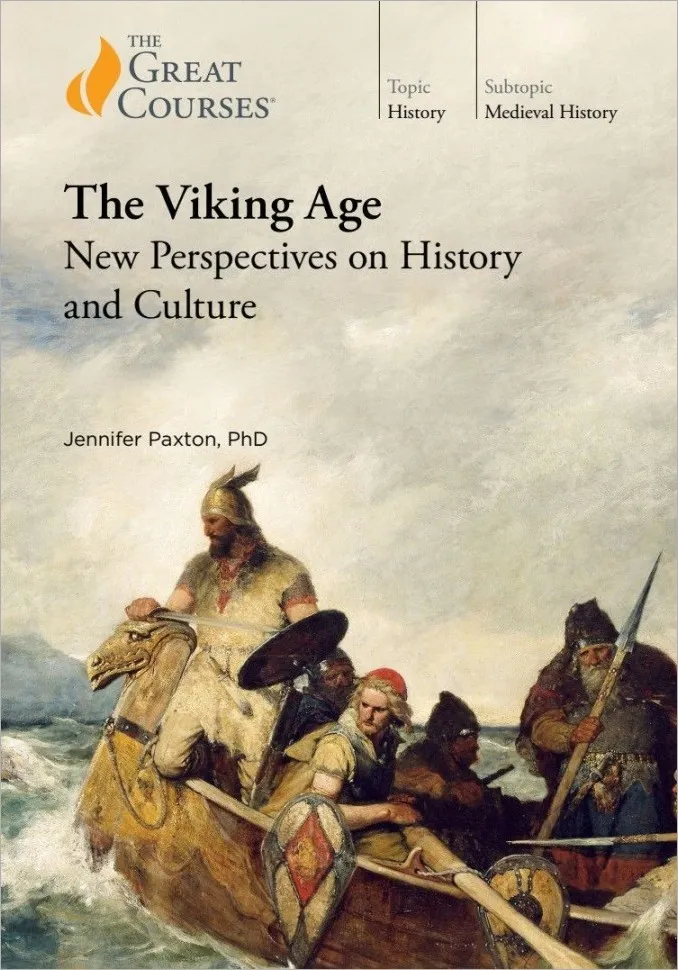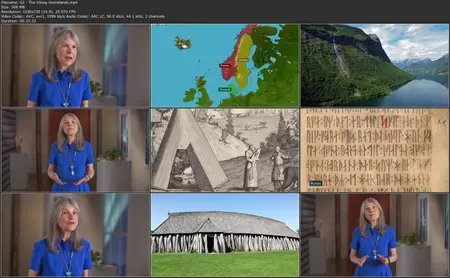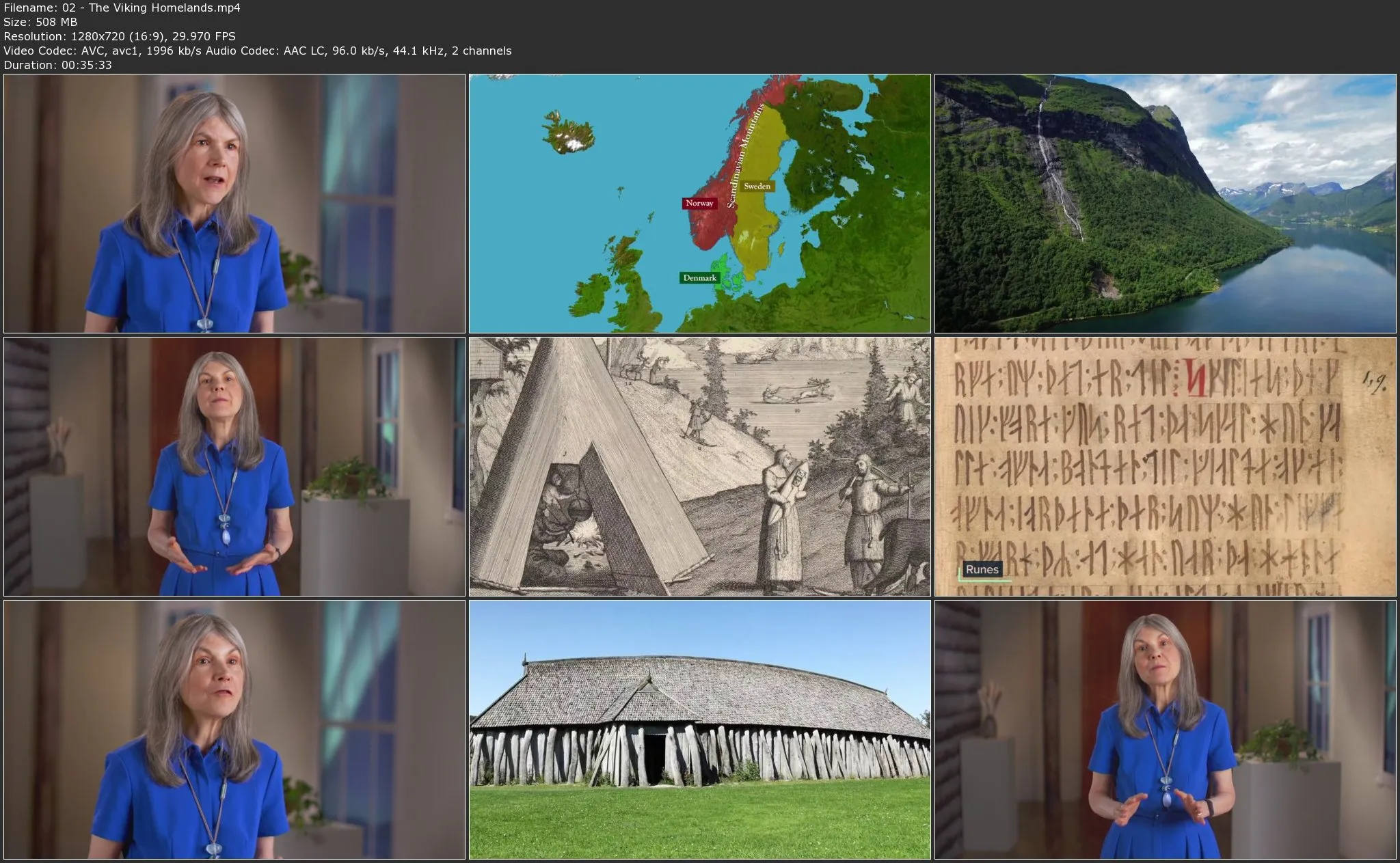TTC Video - The Viking Age: New Perspectives on History and Culture
.MP4, AVC, 1280x720, 30 fps | English, AAC, 2 Ch | 6h 41m | 5.57 GB
Lecturer: Jennifer Paxton, PhD Professor, The Catholic University of America | Course No. 30700
.MP4, AVC, 1280x720, 30 fps | English, AAC, 2 Ch | 6h 41m | 5.57 GB
Lecturer: Jennifer Paxton, PhD Professor, The Catholic University of America | Course No. 30700
In AD 793, a band of Scandinavian pirates descended on the British island of Lindisfarne, where they murdered unsuspecting monks and looted lavish monasteries. For the next two centuries, these terrifying barbarians wreaked havoc on communities stretching from York to Constantinople—through sporadic raiding, strategic kidnappings, or all-out war. A new age had dawned on Europe: the Age of the Viking.
Today, the Vikings are remembered as ferocious pagan warriors. Their weaponry, maritime technologies, and fiery burial practices have become the stuff of legend. Their religious beliefs and the gods they worshiped are enduring sources of inspiration across art, literature, and popular culture. But is there more to the Viking story? What role did violence and religion actually play in Scandinavia and its global outposts? To what extent did England, Ireland, and France change after Viking raids and subsequent conquests? How did women attain power, wealth, and status in a rigidly patriarchal society? How did widespread Christian conversion transform Viking politics and society? And what kinds of relationships did Viking raiders and traders have with the likes of Russia, Ukraine, Byzantium, China, and the Islamic Caliphate?
Dive deeply into these questions and many more with The Viking Age: New Perspectives on History and Culture, a 12-lecture course aimed at correcting course on the Viking period. Your expert is Dr. Jennifer Paxton, a professor of history at the Catholic University of America and a widely published scholar of the Viking Age. Using a combination of literary, textual and archaeological evidence, you will:
Who Were the Vikings?
The Viking Age: New Perspectives on History and Culture paints a very different picture of the Vikings than we are used to. It shifts the focus from the horned helmets and bloody raids to look at the slaves, farmers, and traders who lived across the Viking world—not only in Scandinavia but also in Kyivan Rus, the Danelaw, Constantinople, and beyond. It focuses on Viking women, interrogating the source material and scholarship that had for decades counted them out. It challenges common assumptions about Viking as an identity, by examining archeological records and bone fragments. And it overturns popular myths about the Viking people, from what they wore to how they buried their dead.
You’ll also explore the Viking world in its political, topographical, economic, cultural, and material complexities. As you learn about the diverse religious practices that structured Viking society, from feasting to sacrifice, you’ll also assess how the rise of Christianity transformed Scandinavia on a macro and micro scale. You’ll investigate violence and honor as ideologies and how they impacted Vikings and their allies and adversaries across Europe. You’ll interrogate how the Viking Age is periodized and studied. And you’ll understand how Britain and continental Europe transformed at the hand of their Viking tormentors, looking closely at the conditions that gave rise to raiding in the first place, while also tracing the political and religious developments that brought Viking dominance to an end.
From East to West: Vikings around the World
The Vikings extended their reach well beyond Sweden, Norway, and Denmark. A globetrotting group, the seafaring men from up North touched dozens of polities across the world. They traded with Islamic merchants and Byzantine weavers. They raided the English and Estonian coasts. They erected settlements in Iceland and Greenland. And they set up cities for trading in Ireland and Russia. We cannot understand the Viking Age without following its protagonists on all their seafaring and river crossing adventures, whether for raiding, trading, or permanent settlement.
Across 12 lectures, evaluate how the Vikings engaged with:
By the course’s end, your understanding of the Vikings’ footprint—not just within Scandinavia but around the world—will be much fuller and more illuminated. Your conception of the Vikings in the appropriate social, political, and cultural contexts will be clearer, whether that is in Norway, France, or Kyivan Rus. And you will have followed the Viking world’s most ambitious raiders, traders, and settlers up and down riverways, unto the battlefield, and through resettlement around the globe, enriching your understanding of the real Viking Age.
- Unpack the social, political, and material conditions that pushed men, women, and even whole families out of Scandinavia in the 8th century;
- Dismantle common Viking tropes, from the Vikings’ unique propensity for violence to the myth of the sea burial;
- Get to know the Norse goddesses and saga shieldmaidens who challenged assumptions about Viking women, as well as real life queens, weavers, and local leaders who wielded outsized influence as women in Viking society;
- Reconstruct the famed battles and raids that made Scandinavian warriors so famous—with a critical eye toward the source material and whose interests it served; and
- Follow the Vikings not only to Lindisfarne and Normandy but also to Newfoundland, Greenland, and Kyivan Rus.
Who Were the Vikings?
The Viking Age: New Perspectives on History and Culture paints a very different picture of the Vikings than we are used to. It shifts the focus from the horned helmets and bloody raids to look at the slaves, farmers, and traders who lived across the Viking world—not only in Scandinavia but also in Kyivan Rus, the Danelaw, Constantinople, and beyond. It focuses on Viking women, interrogating the source material and scholarship that had for decades counted them out. It challenges common assumptions about Viking as an identity, by examining archeological records and bone fragments. And it overturns popular myths about the Viking people, from what they wore to how they buried their dead.
You’ll also explore the Viking world in its political, topographical, economic, cultural, and material complexities. As you learn about the diverse religious practices that structured Viking society, from feasting to sacrifice, you’ll also assess how the rise of Christianity transformed Scandinavia on a macro and micro scale. You’ll investigate violence and honor as ideologies and how they impacted Vikings and their allies and adversaries across Europe. You’ll interrogate how the Viking Age is periodized and studied. And you’ll understand how Britain and continental Europe transformed at the hand of their Viking tormentors, looking closely at the conditions that gave rise to raiding in the first place, while also tracing the political and religious developments that brought Viking dominance to an end.
From East to West: Vikings around the World
The Vikings extended their reach well beyond Sweden, Norway, and Denmark. A globetrotting group, the seafaring men from up North touched dozens of polities across the world. They traded with Islamic merchants and Byzantine weavers. They raided the English and Estonian coasts. They erected settlements in Iceland and Greenland. And they set up cities for trading in Ireland and Russia. We cannot understand the Viking Age without following its protagonists on all their seafaring and river crossing adventures, whether for raiding, trading, or permanent settlement.
Across 12 lectures, evaluate how the Vikings engaged with:
- Russia and Ukraine. Follow the Vikings up the Dnieper and Volga Rivers to see how they built up trading meccas in Kyivan Rus, Novgorod, and Staraya Lagoda. And unpack the politically charged controversies that surround the Rus people and their connection to western Europe.
- Asia and the Islamic Caliphate. Trace the carnelian beads found at a famed Viking burial site in Repton, England all the way back to India. And determine how eastern goods like silk, silver, and even a statue of the Buddha made their way to Scandinavia.
- Byzantium. Head southward to explore Viking trading and raiding in the city of Constantinople. And learn about the legendary Varangian Guard.
- Iceland. Accompany Vikings settlers across choppy Atlantic Ocean waters to Iceland to see how they established a highly successful settlement there. And investigate the thrilling Icelandic sagas that continue to influence literature today.
- England and Scotland. Journey across the North Sea to Britain, examining the raids, winter camps, and full-scale military campaigns that characterized Viking exploits on the island. And see how Anglo-Saxon kings defended their kingdoms against the pressure.
- Ireland and France. Study Viking incursions into Ireland and the legacy it left behind. And dive behind the history of Normandy, a French province settled and controlled by the Viking warrior Rollo.
- Greenland. Track Viking adventures in the Western Hemisphere, beginning with Greenland. And investigate why Scandinavian settlers could not tough it out in the icy region.
- Vinland. Travel with the Vikings to investigate their farthest western outposts. And study the footprint Viking explorers left behind, using archeological evidence and popular saga tales.
By the course’s end, your understanding of the Vikings’ footprint—not just within Scandinavia but around the world—will be much fuller and more illuminated. Your conception of the Vikings in the appropriate social, political, and cultural contexts will be clearer, whether that is in Norway, France, or Kyivan Rus. And you will have followed the Viking world’s most ambitious raiders, traders, and settlers up and down riverways, unto the battlefield, and through resettlement around the globe, enriching your understanding of the real Viking Age.





